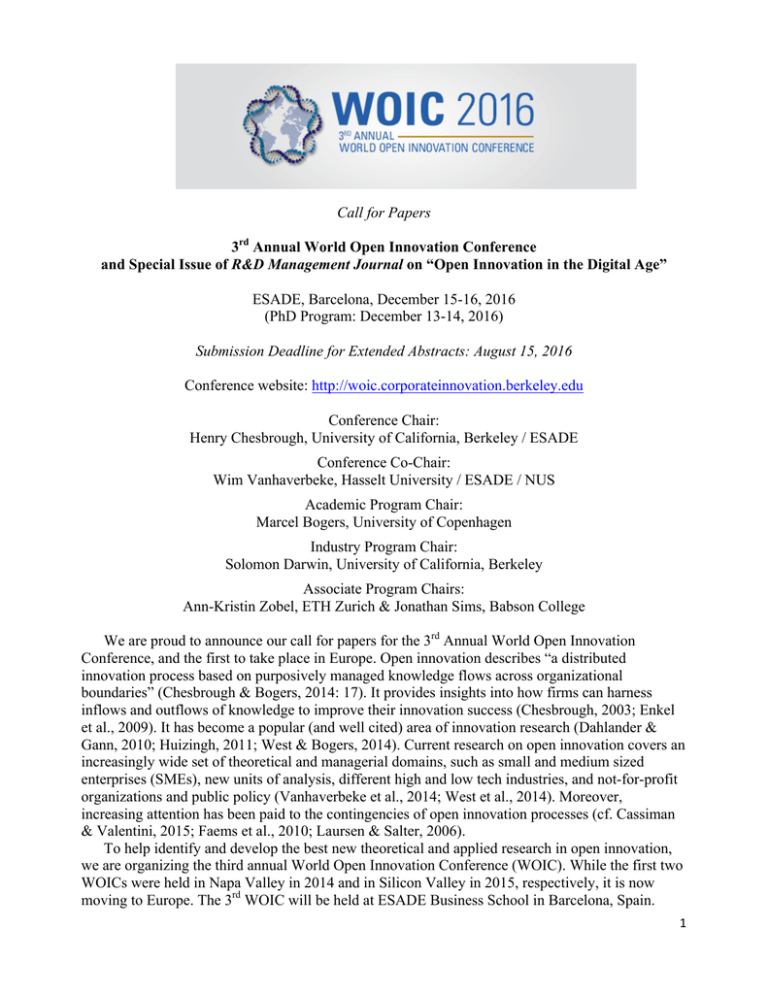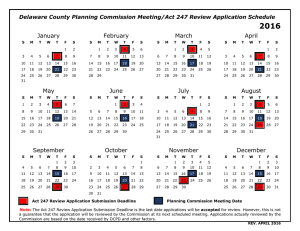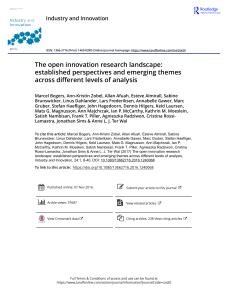PDF here - World Open Innovation Conference 2016
advertisement

Call for Papers 3rd Annual World Open Innovation Conference and Special Issue of R&D Management Journal on “Open Innovation in the Digital Age” ESADE, Barcelona, December 15-16, 2016 (PhD Program: December 13-14, 2016) Submission Deadline for Extended Abstracts: August 15, 2016 Conference website: http://woic.corporateinnovation.berkeley.edu Conference Chair: Henry Chesbrough, University of California, Berkeley / ESADE Conference Co-Chair: Wim Vanhaverbeke, Hasselt University / ESADE / NUS Academic Program Chair: Marcel Bogers, University of Copenhagen Industry Program Chair: Solomon Darwin, University of California, Berkeley Associate Program Chairs: Ann-Kristin Zobel, ETH Zurich & Jonathan Sims, Babson College We are proud to announce our call for papers for the 3rd Annual World Open Innovation Conference, and the first to take place in Europe. Open innovation describes “a distributed innovation process based on purposively managed knowledge flows across organizational boundaries” (Chesbrough & Bogers, 2014: 17). It provides insights into how firms can harness inflows and outflows of knowledge to improve their innovation success (Chesbrough, 2003; Enkel et al., 2009). It has become a popular (and well cited) area of innovation research (Dahlander & Gann, 2010; Huizingh, 2011; West & Bogers, 2014). Current research on open innovation covers an increasingly wide set of theoretical and managerial domains, such as small and medium sized enterprises (SMEs), new units of analysis, different high and low tech industries, and not-for-profit organizations and public policy (Vanhaverbeke et al., 2014; West et al., 2014). Moreover, increasing attention has been paid to the contingencies of open innovation processes (cf. Cassiman & Valentini, 2015; Faems et al., 2010; Laursen & Salter, 2006). To help identify and develop the best new theoretical and applied research in open innovation, we are organizing the third annual World Open Innovation Conference (WOIC). While the first two WOICs were held in Napa Valley in 2014 and in Silicon Valley in 2015, respectively, it is now moving to Europe. The 3rd WOIC will be held at ESADE Business School in Barcelona, Spain. 1 As in the first two WOICs, the conference will allow leading and emerging innovation scholars to present their work, interact with other scholars studying related topics, and hear the latest trends in open innovation research. In addition to academic scholars, the conference seeks to engage open innovation practitioners to understand key challenges they face today as well as opportunities to address such challenges in future research. Selected papers from the conference will be published in a special issue of R&D Management Journal with the theme “Open Innovation in the Digital Age”. More background on the special issue follows below. For the conference in general and the special issue in particular, we are seeking both traditional research papers and those with a more managerial orientation. From the accepted submissions, we will be selecting two academic award winners: the Best Student Paper Award and the Best Emerging Scholar Paper Award. A separate Call for Problems will be used to identify relevant problems and attract managerial participants, while the conference will also feature particular practitioner awards. World Open Innovation Conference Topics The conference seeks original research on a wide range of topics related to open innovation. These include (but are not limited to): • Open innovation in the digital age (specifically for papers to be considered for the special issue, see below for more information). • Open innovation across multiple levels of analysis. • The boundary conditions, moderating effects or contingency factors for open innovation. • The costs, downsides, failures, and negative effects of open innovation • Pecuniary and non-pecuniary mechanisms for enabling open innovation. • Communities, networks, ecosystems, alliances, and other coupled forms of open innovation. • Crowdsourcing, intermediaries, and other ways to organize open innovation. • The role of individuals in the open innovation process. • The role of human resource management practices in open innovation. • The role of technologies in helping (or hindering) open innovation processes. • The relation between open innovation, business models, and strategy. • Open versus proprietary intellectual property (IP) models for open innovation. • The impact of open innovation upon new service offerings. • The effect of government policies in helping (or hindering) open innovation. • The use of open innovation by government and other not-for-profit entities. • The relation between open innovation and entrepreneurship. • How organizational design promotes or hampers open innovation. • Linking open innovation to broader theories of management or economics. • The relation of open innovation (research) to other domains and disciplines, such as operations, finance, marketing, accounting, law, etc. • The role of functional areas beyond R&D, such as manufacturing and marketing, in absorptive capacity and open innovation. • Developing metrics and new research designs for measuring the impact of open innovation. • The interplay between internal and external knowledge flows in innovation processes. • How open innovation relates to other types of openness, such as open source, open science and open access. • How open innovation functions in different contexts, including SMEs, international business, and different industries (low-tech, creative industries, media, food, etc). 2 Submissions We invite submissions of extended abstracts (1,500-3,000 words, all inclusive) for empirical or conceptual papers — with theoretical and/or managerial implications. These will be considered for the research paper portion of the program (see separate Call for Problems for the submissions sought for the managerial/practitioner portion of the program). Guidelines for the submissions are: • 12 point font size, single line spacing and wide margins (2-3 cm/1”); • Include the paper title on the top of the first page; • Do not include author name(s) or any other author-identifying information; • Abstract is optional; • The 1,500-3,000 word count applies to all aspects of the abstract, including references, tables, and figures. The extended abstracts will be reviewed by the WOIC Editorial Board and the reviewer scores will be used as a basis for acceptance decisions. The reviewers will also be asked to provide a short feedback on each of the abstracts they review. Abstracts for research papers will be evaluated along the following criteria: • Theoretical contribution • Methodological rigor • Clarity of writing • Overall fit to open innovation • Fit to “Open Innovation in the Digital Age” (ONLY for those papers that authors want to be considered for the R&D Management special issue). While acceptance decisions will be based on an abstract submission — and thus in some cases the analysis of data may not be fully complete — the submission should describe completed (rather than planned) research. We expect that at least data are collected and initial analyses are done to present preliminary results and conclusions (still noting the above-mentioned criteria). Proposals that talk about data to be collected will be deferred to a future conference. Papers to be considered for the R&D Management special issue should be fully developed in order to be considered for possible submission invitation. Research Papers and the Special Issue Authors of papers accepted for presentation will be required to submit a complete paper prior to the conference; no paper will be required for the poster presentation. The full papers (and abstracts for the posters) will be shared among the conference participants. The journal R&D Management will publish a special issue on “Open Innovation in the Digital Age” with selected papers from this conference. At the time of submission, authors will have the chance to indicate whether or not they wish to be considered for the special issue. The submitted papers will be shortlisted based on the above-mentioned criteria, while final invitation decisions will be made on the basis of the full paper. Authors of selected abstracts will be invited to participate in the special issue, which will be subject to further reviews after the conference. 3 Awards for Best Paper by a Student and Emerging Scholar The conference will also feature an award for the best student (needs to be enrolled as student during year 2016) paper and best emerging scholar (PhD awarded 2011-2016) paper. To be eligible for the award, the student or emerging scholar, respectively, must be the lead author or single author of the paper AND he or she must be the presenting author at the conference. At the time of submission, authors will be asked to indicate whether or not they are eligible for either of these awards. The finalists of the awards will be honored during the conference and on the WOIC website. The winner of each award will receive a plaque and a $1,000 cash reward. About the Conference The conference will include plenary sessions, industry panels, parallel tracks of paper presentations and a poster session. There will also be events prior to the conference, such as a PhD workshop on December 13-14, 2016. See the conference website (http://woic.corporateinnovation.berkeley.edu) for more details and updates. “Rule of One”: Every author is allowed to present only one paper at the conference. It is allowed to have more than one paper accepted, if it is presented by a co-author. The conference will be held at the ESADE Business School in Barcelona, Spain. More information about the location, including logistics, can be found at the conference website. R&D Management Journal Special Issue Submission Information Theme of the Special Issue: Open Innovation in the Digital Age Guest editor team (in alphabetical order): • Marcel Bogers, University of Copenhagen, Denmark • Henry Chesbrough, University of California, Berkeley, USA • Ellen Enkel, Zeppelin University, Germany Background for the Special Issue of R&D Management: One of the erosion factors that has augmented firms’ ability to “leverage increasingly distributed knowledge sources [is] the rise of the Internet (and the related rise of social media), which has brought the knowledge access and sharing capabilities of previously firm-specific internal ICT [information and communication technologies] networks to the World Wide Web” (Chesbrough & Bogers, 2014: 16). This shift has implications for open innovation ranging from how individuals share knowledge within and outside the organization (Dodgson, et al., 2006; Dahlander et al., 2016; Salter et al., 2014) to how organizations manage knowledge flows in innovation ecosystems and platforms (Nambisan & Baron, 2013; Gawer & Cusumano, 2014; Rohrbeck et al., 2009). The digital age provides new enabling factors for generating, sharing, retrieving and storing data, information or knowledge that could dramatically impact how organizations manage their boundaries (Dougherty & Dunne, 2012; Fitzgerald et al., 2013; Whelan et al., 2010). In many cases, managers need to let go of the traditional logic of managing knowledge for innovation that may reside inside or outside the organization, but instead need to find new ways of managing the entire ecosystem where complementary partners are co-innovating new solutions that they can only establish together (cf. Chesbrough et al., 2014; Rayna & Striukova, 2015; van der Borgh et al., 2012). Digital technologies have a far-reaching impact on how individual and organizations innovate together. Moreover, notions as alliances, innovation ecosystems, and the triple helix gain new 4 importance in the digital age (cf. Adner & Kapoor, 2010; Etzkowitz & Leydesdorff, 2000; Faems et al., 2010). The increased opportunities of identifying the solution to an innovation problem through distant search has given rise to new innovation processes and business models, such as crowdsourcing and innovation intermediaries. This is causing important challenges for established firms and startups alike as well as for governments and other organizations. All in all, the digital age provides many opportunities and challenges to the domain of open innovation. While this has major implications for practice, there are also important research questions arising from this background. In the conference and associated special issue, we aim to explore some of these questions, which may be explored using a variety of theoretical perspectives and research designs. Case for the special issue: In this call for papers, our aim is to highlight the need to further our understanding about how open innovation is affected by the digital transformation. The digital age provides many opportunities and challenges for knowledge flows across organizational boundaries to support innovation processes. We can identify several themes associated with research questions, which include (but are surely not limited to): 1) The nature of collaboration in the digital age • How to enable (virtual) collaboration in the digital age, ranging from gatekeepers to ecosystems? • What do open business models in the digital age look like, and how do they complement or substitute other business models? • What are new mechanisms to source, share, filter and evaluate external knowledge? 2) New partners and sources • How can digital technologies help to identify new sources of knowledge in an innovation ecosystem? • How to use open innovation to leverage “smart” solutions (such as smart factories or smart cities)? • Which influence has big or linked data on open innovation? 3) Methodological and empirical opportunities of studying open innovation in the digital age • How to analyze open innovation collaboration in terms of their boundaries, leverage, scope, structure and dynamics? • What are novel ways of examining the interdependency and co-evolution in the open innovation context (multi-method and big data-driven approaches)? • Which actionable research designs could enable both theory building and practical development? 4) Technologies, platforms and methodologies • What is the role of digital technologies and platforms in enabling the connectivity and collaboration between actors (e.g., big data and Industry 4.0)? • How does the nature of platform differ from other types of innovation collaboration? • Are there new methods and tools necessary to enable or investigate collaboration in the digital age? 5 Conference Paper Submission Schedule • July 1, 2016: Submission website opens. • August 15, 2016: Submission deadline for extended abstracts. • September 15, 2016: Notification of accepted papers. • October 15, 2016: Registration deadline for accepted papers. • December 1, 2016: Submission of full papers. • December 13-14, 2016: PhD Program at ESADE, Barcelona. • December 15-16, 2016: Conference at ESADE, Barcelona. • December 31, 2016: Notification of invitations to R&D Management special issue. • February 15, 2017: Submission deadline for papers submitted to R&D Management. References Adner, R., & Kapoor, R. 2010. Value creation in innovation ecosystems: How the structure of technological interdependence affects firm performance in new technology generations. Strategic Management Journal, 31(3): 306-333. Cassiman, B., & Valentini, G. 2015. Open innovation: Are inbound and outbound knowledge flows really complementary? Strategic Management Journal, Published online ahead of print. Chesbrough, H. 2003. Open Innovation: The New Imperative for Creating and Profiting from Technology. Boston, MA: Harvard Business School Press. Chesbrough, H., & Bogers, M. 2014. Explicating open innovation: Clarifying an emerging paradigm for understanding innovation. In H. Chesbrough, W. Vanhaverbeke, & J. West (Eds.), New Frontiers in Open Innovation: 3-28. Oxford: Oxford University Press. Chesbrough, H., Kim, S., & Agogino, A. 2014. Chez Panisse: Building an open innovation ecosystem. California Management Review, 56(4): 144-171. Dahlander, L., & Gann, D. M. 2010. How open is innovation? Research Policy, 39(6): 699-709. Dahlander, L., O'Mahony, S., & Gann, D. M. 2016. One foot in, one foot out: How does individuals' external search breadth affect innovation outcomes? Strategic Management Journal, 37(2): 280-302. Dodgson, M., Gann, D., & Salter, A. 2006. The role of technology in the shift towards open innovation: the case of Procter & Gamble. R&D Management 36(3): 333-364. Dougherty, D., & Dunne, D. D. 2012. Digital science and knowledge boundaries in complex innovation. Organization Science, 23(5): 1467-1484. Enkel, E., Gassmann, O., & Chesbrough, H. W. 2009. Open R&D and open innovation: Exploring the phenomenon. R&D Management, 39(4): 311-316. Etzkowitz, H., & Leydesdorff, L. 2000. The dynamics of innovation: From National Systems and 'Mode 2' to a Triple Helix of university-industry-government relations. Research Policy, 29(2): 109-123. Faems, D., de Visser, M., Andries, P., & van Looy, B. 2010. Technology alliance portfolios and financial performance: Value-enhancing and cost-increasing effects of open innovation. Journal of Product Innovation Management, 27(6): 785-796. Fitzgerald, M., Kruschwitz, N., Bonnet, D., & Welch, M. 2013. Embracing Digital Technology: A New Strategic Imperative, MIT Sloan Management Review, Research Report. Cambridge, MA: Massachusetts Institute of Technology. Gawer, A., & Cusumano, M. A. 2014. Industry platforms and ecosystem innovation. Journal of Product Innovation Management, 31(3): 417-433. Huizingh, E. K. R. E. 2011. Open innovation: State of the art and future perspectives. Technovation, 31(1): 2-9. Laursen, K., & Salter, A. 2006. Open for innovation: The role of openness in explaining innovation performance among U.K. manufacturing firms. Strategic Management Journal, 27(2): 131-150. Nambisan, S., & Baron, R. A. 2013. Entrepreneurship in innovation ecosystems: Entrepreneurs' self-regulatory processes and their implications for new venture success. Entrepreneurship Theory and Practice, 37(5): 10711097. Rayna, T., & Striukova, L. 2015. Open innovation 2.0: Is co-creation the ultimate challenge? International Journal of Technology Management, 69(1): 38-53. Rohrbeck, R., Hölzle, K., & Gemünden, H. G. 2009. Opening up for competitive advantage: How Deutsche Telekom creates an open innovation ecosystem. R&D Management, 39(4): 420-430. 6 Salter, A., Criscuolo, P., & ter Wal, A. L. J. 2014. Coping with open innovation: Responding to the challenges of external engagement in R&D. California Management Review, 56(2): 77-94. van der Borgh, M., Cloodt, M., & Romme, A. G. L. 2012. Value creation by knowledge-based ecosystems: Evidence from a field study. R&D Management, 42(2): 150-169. Vanhaverbeke, W., Chesbrough, H., & West, J. 2014. Surfing the new wave of open innovation research. In H. Chesbrough, W. Vanhaverbeke, & J. West (Eds.), New Frontiers in Open Innovation: 281-294. Oxford: Oxford University Press. West, J., & Bogers, M. 2014. Leveraging external sources of innovation: A review of research on open innovation. Journal of Product Innovation Management, 31(4): 814-831. West, J., Salter, A., Vanhaverbeke, W., & Chesbrough, H. 2014. Open innovation: The next decade. Research Policy, 43(5): 805-811. Whelan, E., Teigland, R., Donnellan, B., & Willie, G. 2010. How Internet technologies impact information flows in R&D: Reconsidering the technological gatekeeper. R&D Management, 40(4): 400-413. 7


